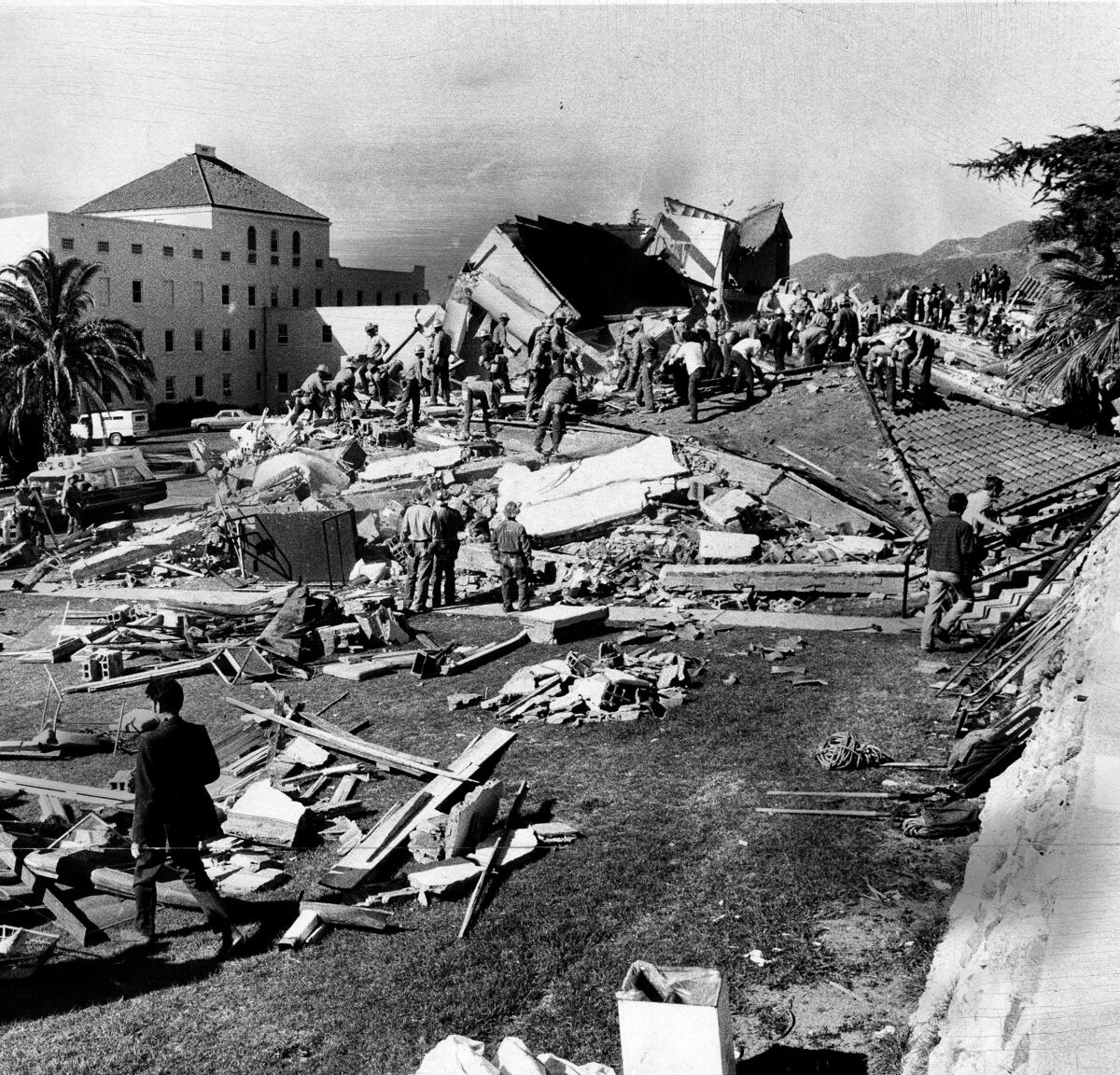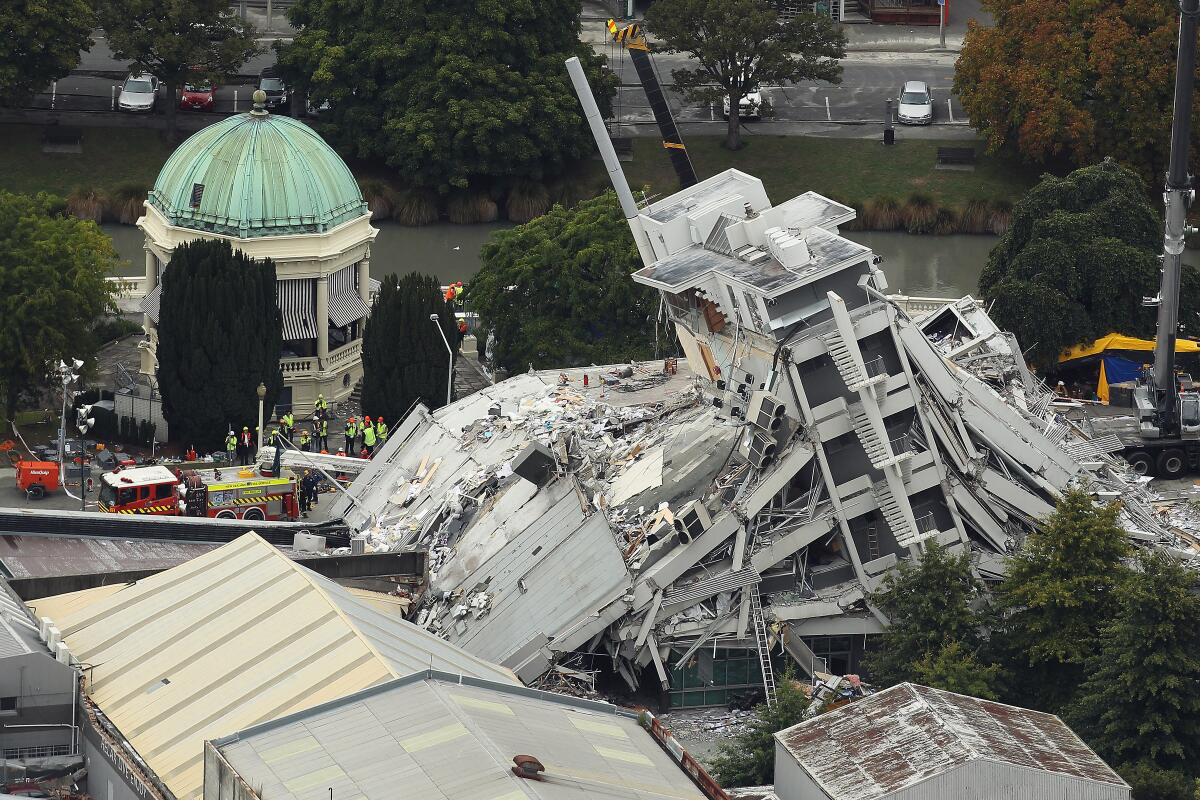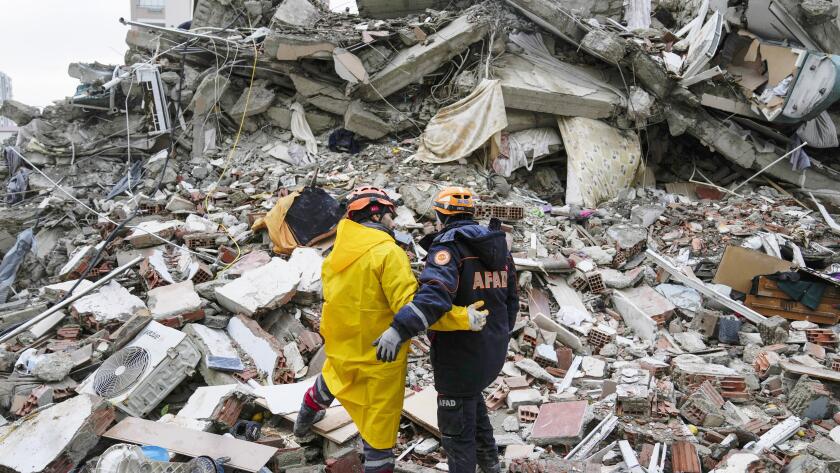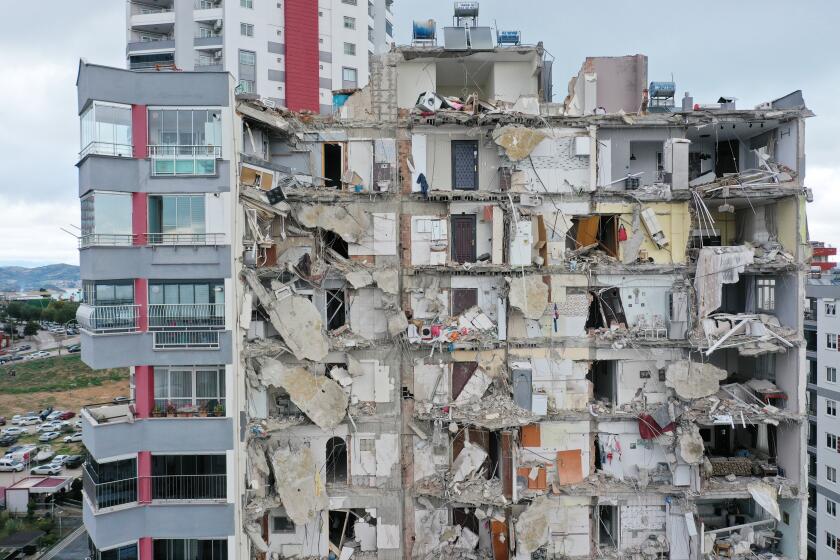A deadly building flaw common in California brings destruction and misery to Turkey, Syria
- Share via
- Share via
As seismic engineers study the earthquakes in Turkey and Syria that killed more than 20,000 people this week, it’s becoming clear that a significant cause of the destruction involved a building design common in California and other parts of the U.S.
The flaws of non-ductile concrete construction are found across the Golden State, with many buildings having not been evaluated or retrofitted and at risk of collapse in a serious earthquake.
It can be tempting for Californians to assume that their structures are inherently better than those in Turkey. But the state hasn’t been tested with a magnitude 7.8 earthquake in more than a century. And that event — the great 1906 earthquake — destroyed much of San Francisco.
It will take time for structural engineers to compile a comprehensive report on the damaged and destroyed buildings in Turkey and Syria. But several experts, looking at photos and videos of the pancaked structures, said the primary flaw is already obvious: They were non-ductile concrete buildings, which have an inadequate configuration of steel reinforcing bars that allows concrete to become brittle and explode out of the structure’s columns when shaken.
“The residential apartment buildings in the area are mostly made of brittle concrete and are extremely vulnerable to the shaking caused by earthquakes,” structural engineering firm Miyamoto International said in a statement.
Concrete frame buildings were popular after World War II and line many of Los Angeles’ most famous boulevards. But their lethal flaws became evident internationally during the 1971 Sylmar earthquake, which occurred 52 years ago Thursday.
In that quake, officials were stunned to find the newly built Olive View Medical Center heavily damaged. The five-story hospital lurched sideways when some of its first-floor columns broke. Three concrete stairwells toppled. A two-story psychiatric building collapsed. Three people died.

A U.S. Geological Survey simulation said it is plausible a magnitude 7.8 earthquake in Southern California could cause 50 non-ductile concrete buildings to fully or partly collapse, with as many as 7,500 people in them.
“We have many thousands of them throughout California, and many tens of thousands of Californians live and work in these buildings,” said USC earth sciences professor James Dolan, an expert on California’s and Turkey’s fault systems. “We know they’re not going to perform well in earthquakes. It’s not a knowledge gap. We understand what’s going to happen to them when they’re shaken in large earthquakes.”
These buildings have shown vulnerabilities in quakes around the globe for half a century, including in Mexico and New Zealand.
The flaw was so egregious that officials quickly banned construction of the non-ductile concrete design after the Sylmar quake and updated minimum building requirements to ensure that future concrete-frame structures erected in the 1980s and beyond would be ductile — or flexible — when shaken. But for decades, governments around the world haven’t required older buildings to be retrofitted.
Many local governments have not required the evaluation or retrofitting of concrete buildings, including some of California’s most populous cities, such as San Jose, San Francisco and Long Beach. Three cities — Los Angeles, Santa Monica and West Hollywood — have ordered retrofits. But the deadline in L.A. is decades away, scheduled for the 2040s.
Structural engineers have praised the mandatory retrofit orders, enacted after a 2013 Times investigation highlighted city officials’ failure to act. And they have voiced grave concern that other cities haven’t taken the same steps.
The USGS said in 2008 that non-ductile concrete structures are one of two building types “most likely to kill people during an earthquake.” Unreinforced masonry, including older brick buildings, is the other type. Many cities in California have ordered unreinforced masonry buildings to be retrofitted or demolished, although some — especially in the Inland Empire — don’t have such a requirement.
Such a quake would be ‘so powerful that it causes widespread damage and consequently affects lives and livelihoods of all southern Californians,’ a report says.
The chief executive of Miyamoto International, structural engineer Kit Miyamoto, warned in an interview that the inaction to require retrofits of non-ductile concrete buildings will end up costing lives in California. He said L.A.’s deadline was too far away, “but at least they have something there. At least the public awareness is there.”
But if other cities don’t act, “that political weakness will kill people,” said Miyamoto, who is also a California seismic safety commissioner and added that his comments were not on behalf of the commission. “They need to be retrofitted. Otherwise, you’re going to see some consequences.”
Non-ductile concrete buildings in Los Angeles suffered catastrophic collapses in the 1971 Sylmar quake — a magnitude 6.6 — and the 1994 Northridge earthquake, a magnitude 6.7. When the Veterans Administration Hospital in Sylmar pancaked during the 1971 quake, 49 people were killed. In the Northridge quake, a Kaiser Permanente office and clinic and a Bullock’s department store partly collapsed.
“If your columns explode outward, your floors are just going to pancake,” Dolan said. “It’s the same thing over and over and over in earthquakes all over the world, where this building type is extremely common. We know that they’re going to fail the same way.”
Another reason why the buildings can be vulnerable to collapse is a lack of proper connections between the vertical columns and the horizontal floors, which break when shaken, Dolan said.
Other factors — including corruption in safety inspections, negligence and incompetence in design practices — have contributed to collapses elsewhere. Government investigators probing the collapse of the CTV building in Christchurch, New Zealand, during a 2011 earthquake found that a person handling its structural design in the 1980s “was working beyond his competence.” The structure’s collapse killed 115 people.
The collapse of the Pyne Gould Corp. building in the Christchurch quake caused 18 additional deaths. In that case, investigators determined that the structure, built in the early 1960s to standards in place at the time, could not have been lawfully constructed in 2011. Investigators also uncovered documents from 1997 showing that structural engineers hired by the building’s owner warned of the potential of a collapse in an earthquake but also noted that “damage reduction measures are optional.”

Some California cities say they are exploring retrofits of a different type of flawed structure: soft-story apartment buildings — also called dingbats — that have flimsy ground stories often to accommodate carports or garages. The collapse of one such complex in the 1994 Northridge earthquake left 16 people dead.
“At this time, we are not addressing non-ductile concrete buildings,” Lisa Joiner, a San Jose building division deputy director, said in a statement. However, San Jose — Northern California’s most populous city — has ordered an inventory of soft-story apartments and is discussing ordinances to require retrofits of them. Long Beach, L.A. County’s second-most populous city, is doing the same.
A decade ago, San Francisco became one of the first cities to require retrofits of soft-story apartments. Of nearly 5,000 buildings covered by the city’s ordinance, 90% are now retrofitted. But San Francisco still has no requirement to retrofit non-ductile concrete buildings, of which there are 2,000 to 3,000 in the city.
“We’ve been making steady progress toward developing an ordinance,” Brian Strong, San Francisco’s chief resilience officer and director, said in an email.
Los Angeles, Santa Monica and West Hollywood have laws that cover retrofitting of both non-ductile concrete buildings as well as soft-story apartment buildings.
But Dolan urged other California cities to work faster to address these fatal building flaws.
“This is a really significant threat to life and limb that needs to be taken much more seriously,” he said.
More Times coverage of concrete building risk from earthquakes
Times investigation: Buildings across L.A. have hidden risk of collapse in earthquake
Why are concrete towers potentially unsafe?
Map: Where are concrete buildings in L.A.? Search our database
The UC list of vulerable buildings
L.A. requires retrofitting of concrete buildings
Where L.A. stands with retrofits
More to Read
Sign up for Essential California
The most important California stories and recommendations in your inbox every morning.
You may occasionally receive promotional content from the Los Angeles Times.













